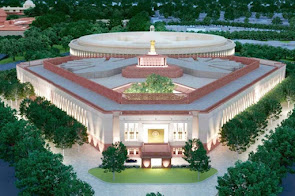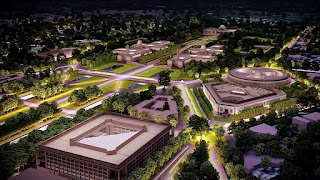INDIA’S NEW PARLIAMENT
In October 2019, both houses of parliament passed a resolution for a new parliament. No member of parliament had recorded dissent. Some critics of Modi are not questioning the need for the project but all of them are asking, why now? They argue that the economy is facing hardship and the country is facing a pandemic and the money for this project could be diverted to social welfare. The cost of the new parliament building is around ₹900 crore. It is a part of the 20,000-crore Central Vista project. According to the Central Public Works Department (CPWD)’s latest proposal for the redevelopment of Central Vista, the prime minister’s new residential complex will have 10 four-story buildings with a maximum height of 12 meters. The CPWD, which is executing the project has revised the estimated cost from Rs. 11,794 crores to Rs 13,450 crores. The Central Vista project involves the redevelopment of the area known as Central Vista Avenue, the area between the Rashtrapati Bhavan and the India Gate, where all the important buildings related to the Union government are located. This has two main parts, a new parliament building, and a new secretariat complex to bring all the central government ministries in one place. The third part involves the development of the Rajghat and the area around it, which is available to the General Public, including the development of public amenities. This project will involve the demolition of some non-heritage buildings in the area and construction of the new buildings in their place of them.

FEATURES OF THE NEW PARLIAMENT BUILDING
On 10 December, Prime Minister Narendra Modi laid the foundation stone of the new parliament building. Architect Bimal Patel said that the new building will have a triangular shape to reflect the importance of the triangle being a sacred geometry in various religions and cultures of India. In the Lok Sabha chamber, the national bird (peacock) is used as the theme. In the Rajya Sabha, the national flower (lotus) is used and in the Central Hall, the national tree (banyan) is used. The new parliament building would be a symbol of “Atmanirbhar Bharat” and a “Temple of Democracy” for Independent India. The building is to be constructed by Tata Project Ltd. which would have a built-up area of 64,500 square meters over four floors and would be built adjacent to the existing building over 22 months. The building would have modern equipment to be earthquake-safe and could accommodate up to 1,224 MPs during joint sessions in the Lok Sabha chamber. The Lok Sabha and the Rajya Sabha chamber would accommodate 888 and 384 MPs respectively. The new building will also have a grand constitution hall to showcase India’s democratic heritage, a lounge for members of parliament, a library, multiple committee rooms, dining areas, and ample parking space. Birla said sufficient steps have been taken to control air and noise pollution during the construction work for the new parliament building. The new parliament building will be eco-friendly, where electricity consumption will also be 30 percent lower than before.

WHY INDIA NEEDS A NEW PARLIAMENT BUILDING?
The present parliament building is a British-era structure, designed by Edwin Lutyens and Herbert Baker who were responsible for the planning and construction of New Delhi. The government informed parliament that the building is showing signs of distress and overutilization, which is one of the reasons for the proposed construction of a new parliament House. The existing building is a massive circular tower of 560 feet in diameter. The Parliament House Estate is enclosed by an ornamental red sandstone wall or iron grills with iron gates that can be closed when the occasion demands. The building has twelve gates. Presently the number of Loksabha seats is 545 based on delimitation carried out based on the 1971 census and it is likely to increase after 2026 as the number of seats has been frozen till then. The current Rajya Sabha has a total strength of 245 seats. At present, the old parliament house has a central hall with a total capacity of 436 people. The joint session of both houses has been held in this central hall till now.
CONCLUSION
The new parliament building is expected to remain an integral part of the country’s parliamentary system for the next 150 years. The new Parliament House will continue to proclaim the great Indian democracy and self-reliant India on the world stage for hundreds of years t


